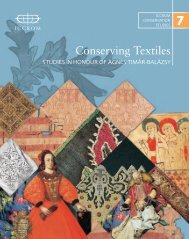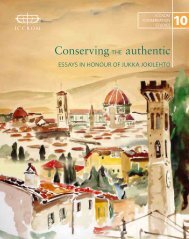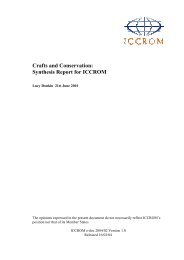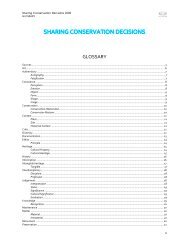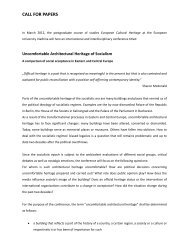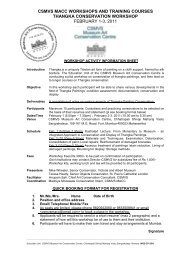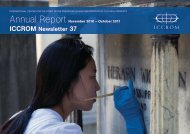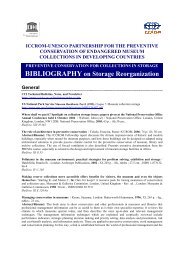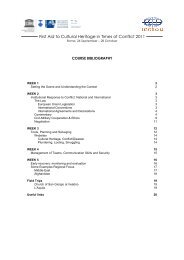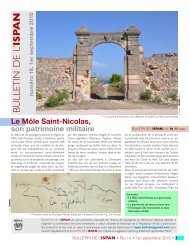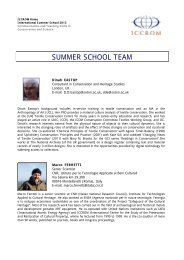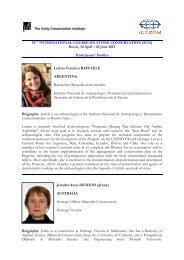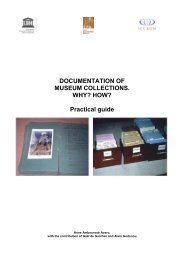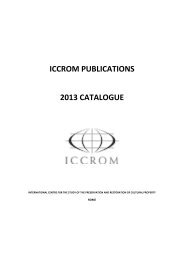part 1 - Iccrom
part 1 - Iccrom
part 1 - Iccrom
Create successful ePaper yourself
Turn your PDF publications into a flip-book with our unique Google optimized e-Paper software.
MEASURING HERITAGE CONSERVATION PERFORMANCE<br />
6th International Seminar on Urban Conservation<br />
Air travel in <strong>part</strong>icular can contribute enormous<br />
amounts of greenhouse gases that are pumped into<br />
the atmosphere, something that is often intentionally<br />
or unintentionally overlooked. A round-trip<br />
economy class flight from New York to Shanghai, for<br />
instance, contributes 2,000 kg of CO 2<br />
(International<br />
Civil Aviation Organization, 2010). Air travel should<br />
therefore be considered in all conservation activities,<br />
including human and materials transportation<br />
for conservation projects, meetings, seminars and<br />
training courses. A number of methods to calculate<br />
carbon emissions have been created (see Carbon<br />
Footprint, 2010; The Nature Conservancy, 2010),<br />
which could be easily incorporated into integrated<br />
methodologies for measuring the results of conservation<br />
actions.<br />
Preventive conservation of collections may also be<br />
very demanding in terms of the energy required for<br />
environmental control, especially air conditioning,<br />
which produces large carbon emissions. Measurements<br />
of energy bills should therefore be monitored<br />
and targets regarding the efficiency and possible<br />
reduction of energy use should be established. In<br />
recent years, a special focus has been given to developing<br />
sustainable approaches for the control of environmental<br />
conditions within museums, <strong>part</strong>icularly<br />
by looking at the possibilities offered by traditional<br />
building techniques (Toledo, 2006).<br />
In addition to the emission of greenhouse gases,<br />
there are many conservation materials and process<br />
that can have a considerable negative impact on the<br />
environment. They include the use and discard of<br />
solvents and other toxic substances such as biocides,<br />
adhesives and consolidants, as well as the discard<br />
of various types of solid waste such as packaging<br />
material used in collections, and rubble produced by<br />
architectural restoration. Some indicators for such<br />
impacts may be found in Hammond et al. (1995, p.<br />
20).<br />
7.3. An example of environmentallyaware<br />
methodology<br />
One of the few methodologies that considers environmental<br />
impacts as criteria for evaluation is the<br />
National Trust’s Triple Bottom Line Tool, which aims<br />
at assessing the impact that conservation activities<br />
have on people, finance and the environment. The<br />
theoretical underpinnings of this approach derive<br />
from sustainable frameworks, in <strong>part</strong>icular the<br />
World Commission on Environment and Development,<br />
which defines sustainable development as<br />
“development that meets the needs and aspirations<br />
of the present without compromising the ability of<br />
future generations to meet their own needs” (World<br />
Commission on Environment and Development,<br />
1987, p. 43).<br />
The criteria of the Triple Bottom Line Tool include<br />
energy and water consumption, as well as waste and<br />
carbon footprint. This assessment tool includes not<br />
only the impact of building and conservation activities,<br />
but also indirect activities such as human and<br />
materials transportation related to the projects and<br />
the amounts of greenhouse emissions they produce.<br />
In summary, the environmental aspect is also a<br />
highly overlooked area of assessment of conservation<br />
activities, although some countries have started<br />
to incorporate these issues in their evaluation methodologies.<br />
It is beyond the scope of this paper to<br />
review all the literature of environmental indicators<br />
but a good review can be found in Niemi and<br />
McDonald (2004).<br />
Conclusions<br />
Due to the fact that definitions and aims of heritage<br />
conservation have widened during the last decades,<br />
there is a need to develop new approaches and methodologies<br />
for assessing the performance of conservation<br />
activities. One of the most important tendencies<br />
in conservation has been the shifting of attention<br />
from cultural heritage to the people that value such<br />
heritage.<br />
There is a growing need to evaluate the efficacy<br />
of conservation activities. However, indicators and<br />
methodologies of assessment are much needed in<br />
order to capture the necessary data to monitor the<br />
conservation of values entailed in cultural heritage,<br />
as well as the economic, social and environmental<br />
impacts that conservation activities may produce.<br />
Assessments are needed in order to communicate<br />
to funding bodies, policy makers and the interested<br />
public with sound and convincing data about the<br />
possible benefits of conservation. However, it must<br />
be stressed that both positive and negative impacts<br />
of all aspects involved in conservation practice<br />
should be assessed. In this sense, it is emphasized<br />
that the aim of assessments should not be to demonstrate<br />
the benefits of conservation, but to evaluate<br />
the performance of this activity in order to guide<br />
future interventions, maximize benefits and avoid<br />
negative impacts.<br />
In trying to evaluate the performance of conservation,<br />
a comprehensive stance has to be taken in order<br />
to avoid overlooking the multidimensional nature of<br />
cultural heritage and the material and nonmaterial<br />
Alonso, V. I. & V. M. Meurs. 2012. Assessing the performance of conservation activities. In Zancheti, S. M. & K. Similä, eds. Measuring<br />
heritage conservation performance, pp. 1-14. Rome, ICCROM.<br />
10



